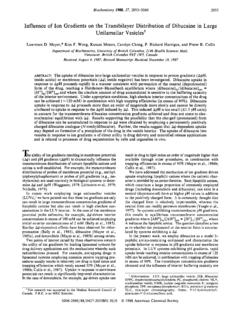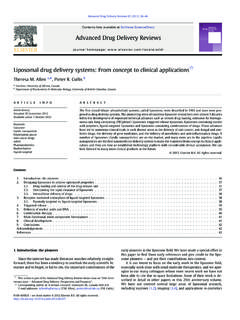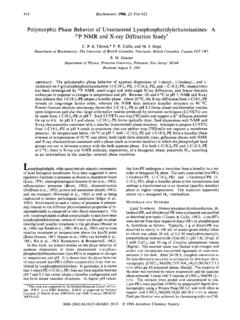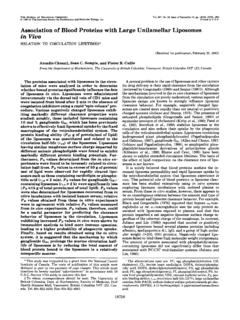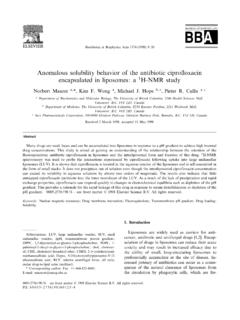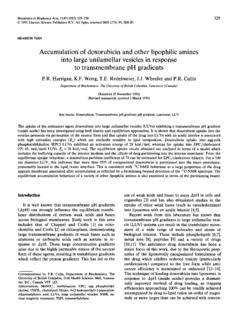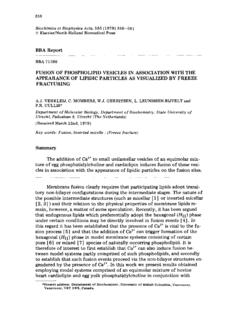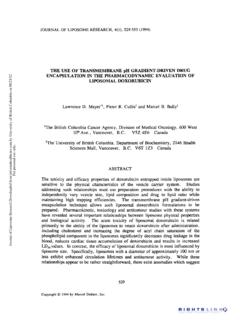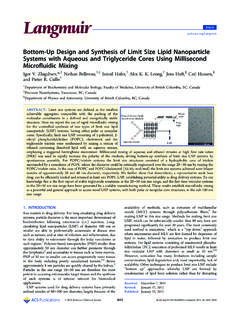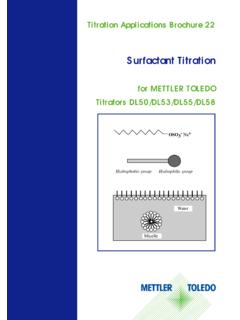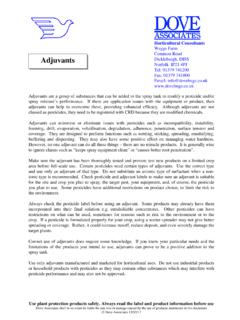Transcription of RESEARCH ARTICLE On the mechanism whereby cationic …
1 Gene Therapy (2001) 8, 1188 1196 2001 Nature Publishing Group All rights reserved 0969-7128/01 $ ARTICLEOn the mechanism whereby cationic lipids promoteintracellular delivery of polynucleic acidsIM Hafez1, N Maurer1and PR Cullis1,21 Department of Biochemistry and Molecular Biology, Faculty of Medicine, University of British Columbia, Vancouver, BC; and2 Inex Pharmaceuticals Corporation, Burnaby, BC, CanadaThe mechanism whereby cationic lipids destabilize cellmembranes to facilitate the intracellular delivery of macro-molecules such as plasmid DNA or antisense oligonucleot-ides is not well understood. Here, we show that cationic lip-ids can destabilize lipid bilayers by promoting the formationof nonbilayer lipid structures. In particular, we show that mix-tures of cationic lipids and anionic phospholipids preferen-tially adopt the inverted hexagonal (HII) phase. Further, thepresence of helper lipids such as dioleoylphosphatidyle-Keywords:lipoplexe s; transfection; lipid polymorphism; gene therapyIntroductionThe cell membrane presents a major barrier to the intra-cellular delivery of macromolecules such as plasmids,antisense oligonucleotides and therapeutic proteins.
2 Anumber of approaches for enhancing the intracellulardelivery of nucleic acids and proteins have been investi-gated, including the use of liposomes,1membrane-trans-locating peptides,2cationic peptides,3cationic proteins,4cationic polymers5and cationic lipidsprovide a particularly powerful tool for the introductionof polynucleic acids into cells. For example, cationiclipid nucleic acid complexes or lipoplexes can promotethe intracellular delivery of plasmid DNA,6 RNA,7anti-sense oligonucleotides,8transcription factor decoy oligon-ucleotides,9ribozymes10and transcription lipid in complexes with plasmids or otherpolynucleic acids performs at least three functions. First,by electrostatic association with the plasmid, the cationiclipid coats and partially condenses the plasmid to formthe transfection-competent particle. Second, the presenceof cationic lipid at levels that give rise to an overall posi-tive charge leads to enhanced association of the lipoplexwith negatively charged cell surfaces12leading to cellularuptake via ,14 Third, following uptake, thecationic lipid plays a role in destabilizing the endosomalmembrane,15 17thus facilitating cytoplasmic delivery ofthe plasmid.
3 The mechanism whereby cationic lipiddestabilizes the endosomal membrane remains ill-definedand is the subject of this : PR Cullis, Department of Biochemistry and MolecularBiology, Faculty of Medicine, University of British Columbia, Vancouver,BC, CanadaReceived 14 September 2000; accepted 30 April 2001thanolamine or cholesterol, lipids that enhance cationic lipid-mediated transfection of cells also facilitate the formation ofthe HIIphase. It is suggested that the ability of cationic lipidsto promote nonbilayer structures in combination with anionicphospholipids leads to disruption of the endosomal mem-brane following uptake of nucleic acid cationic lipid com-plexes into cells, thus facilitating cytoplasmic release of theplasmid or Therapy (2001)8,1188 work has shown that cationic lipids interactstrongly with systems containing anionic lipids. Forexample, cationic liposomes fuse with liposomes contain-ing anionic phospholipids12,18,19and addition of anioniclipids to cationic lipid nucleic acid complexes displacescationic lipid from the nucleic acid to form ion pairs ofcationic and anionic lipid and free nucleic 22 Here, we characterize the structural preferences of the ionpairs formed from mixtures of cationic lipids and anionicphospholipids using31P NMR techniques.
4 We show thatthese mixtures preferentially adopt the nonbilayerinverted hexagonal (HII) phase and that helper lipidssuch as dioleoylphosphatidylethanolamine (DOPE) orcholesterol further facilitate formation of such nonbilayerstructure. These results suggest that cationic lipids dis-rupt the endosomal membrane by inducing formation ofnonbilayer lipid of cationic lipids and anionic phospholipidsadopt the hexagonal HIIphaseIn previous work we have shown that mixtures of thecationiclipidN,N-dioleyl-N,N-dimethyl ammoniumchloride (DODAC) with the anionic lipid cholesterylhemisuccinate (CHEMS) can form nonbilayer structuressuch as the hexagonal HIIphase under conditions of neu-tral surface , mixtures of the cationiclipid3 -[N-(N ,N -dimethylaminoethane)-carbamoyl]choleste rol hydrochloride (DC-Chol) and dioleoylphos-phatidic acid (DOPA) also exhibit HIIphase studies were conducted to determine whether thisbehaviour is a general property of mixtures of cationicand anionic lipids.
5 In the first set of experiments, mechanism of intracellular delivery systemsIM Hafezet al1189dioleoylphosphatidylserine (DOPS) was used as theanionic lipid and was mixed with equimolar amounts ofa variety of cationic lipids, including DODAC, N-[1-(2,3-dioleyloxy)propyl]-N,N,N-trime thylammonium chloride(DOTMA),61,2-dioleoyloxy-3-(trim ethylammonio) pro-pane (DOTAP)12and phase behaviour ofthese dispersions could be investigated using31P NMRtechniques due to the presence of the phosphate groupon the phospholipids. As shown in Figure 1a, a disper-sion of the anionic phospholipid DOPS prepared at reveals the characteristic asymmetric31P NMR linesh-ape with a lowfield shoulder and a highfield peak asso-ciated with bilayer , the samplescomposed of equimolar mixtures of DOPS and DODAC,DOTMA and DOTAP (Figure 1b d, respectively) all gaverise to31P NMR spectra that are a factor of two narrowerand exhibit reversed asymmetry compared with the bilayer lineshape and are characteristic of phospholipidsorganized in the inverted hexagonal (HII) ,26 Itmay be noted that the31P NMR spectrum obtained forthe equimolar mixture of DC-Chol/DOPS (Figure 1e) isconsistent with the co-existence of both HIIand 1 Equimolar mixtures of cationic lipids and anionic phospholipidsadopt the hexagonal NMR spectra obtained from aqueousdispersions of (a) DOPS, (b) DODAC/DOPS, (c)
6 DOTMA/DOPS, (d)DOTAP/DOPS,(e)DC-Chol/DOPS,(f)DODAC/D OPA,(g)DODAC/LBPA, (h) DODAC/CL (1:2; molar ratio), (i) DODAC/PI, (j) TherapyThe second set of experiments, performed to establishthe generality of the observation that mixtures of cationicand anionic lipids adopt HIIphase structure, examinedthe structural preferences of mixtures of DODAC with avariety of different species of phospholipids. Theseincluded DOPA, lysobisphosphatidic acid (LBPA; a majorcomponent of late endosomal membranes27), tetraoleoyl-cardiolipin (CL), liver-derived phosphatidylinositol (PI)and 1-palmitoyl-2-oleoyl phosphatidylglycerol (POPG).As shown in Figures 1f, g, h, i and j for mixtures ofDODAC with DOPA, LBPA, CL, PI and POPG, respect-ively,31P NMR spectra consistent with lipids organizedinto the HIIphase were observed for all these these experiments, anionic phospholipids weremixed with an equimolar amount of DODAC, with theexception of cardiolipin, a bivalent lipid, which wasmixed with two molar equivalents of DODAC.
7 Theremarkable potency of DODAC and, by extension, othercationic lipids for inducing HIIphase structure is inherentin the fact that PS, PA, CL, PI and PG all adopt the bilayerorganization in isolation at neutral pH and all can stabil-ize nonbilayer lipids such as DOPE into a of helper lipidsPlasmid DNA cationic lipoplexes used for transfectionare usually derived from mixtures of plasmid with lipo-somes composed of cationic lipids and helper lipidssuch as DOPE6,15,29,30or 34 These helper lip-ids give rise to improved transfection potencies of theresulting complex. If the mechanism of action of cationiclipids relies on an ability to induce HIIphase or relatednonbilayer structure to destabilize target membranessuch as the endosomal membrane it would be expectedthat these helper lipids would also promote HIIorganiza-tion. Conversely, it would be expected that lipids such asdioleoylphosphatidylcholine (DOPC), which give rise toreduced levels of transfection when present in com-plexes,6,35,36would hinder the ability of cationic lipids toinduce nonbilayer structure.
8 That this is the case is illus-trated in Figure 2. As shown in Figure 2a, aqueous dis-persions of DOPS/DOPC (1:1; molar ratio) adopt thebilayer structure. As shown in Figure 2b for a lipid dis-persion containing DODAC/DOPS/DOPC (1:1:1; molarratio), the addition of an equimolar amount of DODAC(with respect to DOPS) does not result in induction of HIIphase structure. Thus the presence of DOPC prevents theDODAC DOPS ion pairs from adopting the HIIphasethey would otherwise behaviour contrasts with the properties of lipidsused as helper lipids. As shown in Figure 2c, aqueousdispersions of DOPS/DOPE (1:1; molar ratio) adopt thebilayer phase, consistent with the ability of DOPS to sta-bilize DOPE in the lamellar organization as noted addition of equimolar amounts of DODAC(with respect to DOPS) results in a complete transitionto HIIphase organization as shown in Figure 2d for aDODAC/DOPS/DOPE (1:1:1; molar ratio) , the addition of DOPE to the DOPC-contain-ing lipid dispersion of Figure 2b results in a transitionto HIIphase organization as shown in Figure 2e for aDODAC/DOPS/DOPC/DOPE (1:1:1:1; molar ratio) lipiddispersion.
9 This is consistent with the preference ofDOPE for the HIIphase in isolation26and again pointsMechanism of intracellular delivery systemsIM Hafezet al1190 Gene TherapyFigure 2 The helper lipids DOPE and cholesterol promote the formationof the hexagonal HIIphase structure in lipid mixtures containing cationicand anionic NMR spectra obtained from aqueous dispersionsof (a) DOPS/DOPC (1:1; molar ratio), (b) DODAC/DOPS/DOPC (1:1:1;molar ratio), (c) DOPS/DOPE (1:1; molar ratio), (d) DODAC/DOPS/DOPE (1:1:1; molar ratio), (e) DODAC/DOPS/DOPC/DOPE (1:1:1:1;molar ratio), (f) DODAC/DOPS/DOPC/Chol (1:1:1:1; molar ratio).to the ability of the helper lipid DOPE to facilitate HIIphase has similar abilities to promote HIIphaseorganization. This is illustrated by the influence of choles-terol on the structure of the DODAC/DOPS/DOPC(1:1:1; molar ratio) system which, as previously indicated,adopts the bilayer organization (Figure 2b).
10 As shown inFigure2fforaDODAC/DOPS/DOPC/cholestero l(1:1:1:1; molar ratio) lipid dispersion, the inclusion ofcholesterol induces HIIphase structure. This is consistentwith the previously noted ability of cholesterol to pro-mote the HIIphase in a variety of mixed 40 Influence of cationic lipid structure on the polymorphismof mixtures of cationic and anionic lipidsIt is well known that the chemical structure of cationiclipids can strongly influence the transfection potency ofplasmid DNA cationic lipid complexes formed fromthem. Although a detailed correlation between the trans-fection potency of complexes formed from different cat-ionic lipids and the polymorphic phase preferences ofthese lipids in mixtures with anionic lipids is outside thescope of this study, it is important to point out that theability of cationic lipids to adopt HIIphase structure doesoffer the possibility of obtaining a measurable parameterto correlate with transfection potency.
